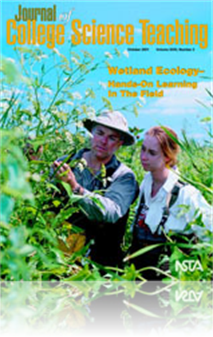All Journal of College Science Teaching resources
Journal Article
Design Technology: Children’s Engineering (Dunn and Larson 1990), is a learning model that allows children to experience developmentally appropriate, hands-on instructional methods that enable them to draw, plan, design, build, test, and improve th...
Journal Article
Note Sheets: A Reliable Predictor of Success?
Students in a large introductory-level biology course brought one page of notes to their exams. The authors scored these note sheets for their format and content. Student performance on exams showed a very limited correlation with the format or conte...
Journal Article
The Case Study: The Cheerleader and the Football Player
This is a classic engineering problem involving pulleys. It is suitable for any basic class where Newtonian mechanics are discussed. The objective of the case is straightforward: to teach the mechanical principle of the pulley. The story attempts to ...
Journal Article
Internet Courses: Are They Worth the Effort?
To investigate the effectiveness of an Internet-delivered course, one group of biology students learned the course material employing Internet resources while a second group attended a traditional, lecture-based class. The authors, comparing student ...
Journal Article
Favorite Demonstration: Illustrating Heterochrony and Heterotopy
This article describes an inexpensive, simple method using balloons to demonstrate heterochrony and heterotopy in the classroom. The method can be used to supplement lectures and assigned readings for a course, especially in cases where heterotopy is...
Journal Article
Wetland ecology is a complex subject that draws from several scientific disciplines. While classroom lectures are necessary to teach the vast body of scientific data, there is no substitute for field and laboratory experiences to enrich learning. Thi...
Journal Article
Why Does My Cruorine Change Color?
The classical research literature provides material appropriate for use in problem-based courses. Here, the spectroscopic study by G. G. Stokes of the reversible “oxidation and reduction” of hemoglobin illustrates how a series of open-ended group...
Journal Article
Reading Your Way to Scientific Literacy
Having students read and analyze scientific articles gives them an understanding of scientific information as presented in the literature. After studying classic and recent research articles, students answer homework questions, individually and in gr...





